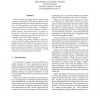109
click to vote
CDC
2010
IEEE
14 years 8 months ago
2010
IEEE
Subspace identification has proven useful when identifying identifying multi-input multi-output systems. It is, however, important in many applications to take a priori structural ...
101
click to vote
SIAMCO
2010
14 years 11 months ago
2010
We consider a network consisting of n interconnected nonlinear subsystems. For each subsystem an ISS Lyapunov function is given that treats the other subsystems as independent inpu...
105
Voted
ISSRE
2010
IEEE
14 years 11 months ago
2010
IEEE
—Large scale systems (LSS) contain multiple subsystems that interact across multiple nodes in sometimes unforeseen and complicated ways. As a result, pinpointing the subsystems t...
95
Voted
ICANN
2010
Springer
15 years 1 months ago
2010
Springer
In previous work, we have developed a "Glance-Look" model, which has replicated a broad profile of data on the semantic Attentional Blink (AB) task and characterized how ...
CDC
2009
IEEE
15 years 5 months ago
2009
IEEE
— This paper considers networks consisting of integral input-to-state stable (iISS) subsystems and addresses the problem of verifying iISS property of a given network. First, we ...
126
click to vote
MIDDLEWARE
2004
Springer
15 years 6 months ago
2004
Springer
This paper surveys a variety of subsystems designed to be the building blocks from which sophisticated infrastructures for ubiquitous computing are assembled. Our experience shows...
106
click to vote
ICRA
2005
IEEE
15 years 6 months ago
2005
IEEE
— We propose a novel modular underwater robot which can self-reconfigure by stacking and unstacking its component modules. Applications for this robot include underwater monitor...
119
Voted
APSEC
2006
IEEE
15 years 7 months ago
2006
IEEE
Coupling and cohesion between subsystems are commonly studied metrics when analyzing the architecture of software systems. It is usually desirable for subsystems to have high cohe...
100
click to vote
WCRE
2007
IEEE
15 years 7 months ago
2007
IEEE
Reverse engineering legacy software systems often involves the employment of clustering algorithms that automatically decompose a software system into subsystems. The decompositio...
106
click to vote
RTSS
2008
IEEE
15 years 7 months ago
2008
IEEE
This paper presents algorithms that (1) facilitate systemindependent synthesis of timing-interfaces for subsystems and (2) system-level selection of interfaces to minimize CPU loa...





